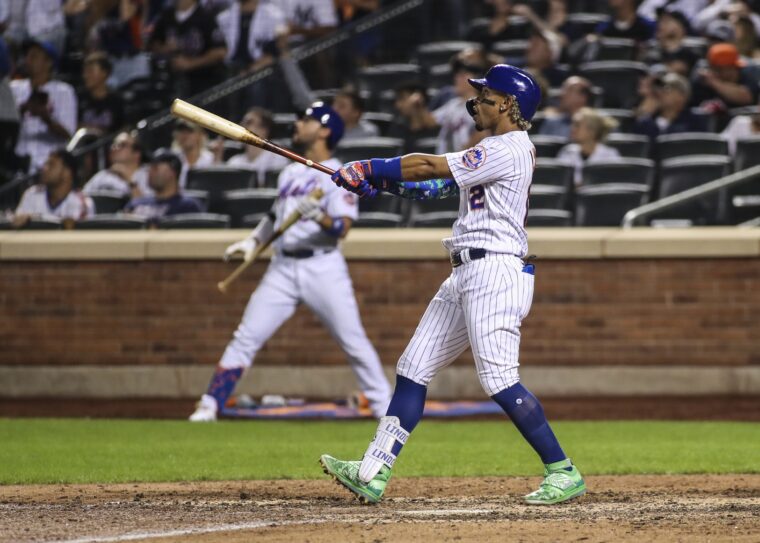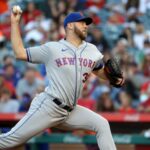
Mandatory Credit: Wendell Cruz-USA TODAY Sports
Another regular season is in the books for the New York Mets, and unfortunately, it’s another one that doesn’t include postseason play. Since I’ve already spent some time talking about the not-so-fun stuff, I’m going to switch gears and be a little more positive.
We’re going to find (at least) one encouraging statistic from this season for each Mets hitter, which will admittedly be easier for some than others. In order to be included below, players had to finish the year on New York’s roster (whether they were active or on the injured list) and accumulate at least 100-plus plate appearances (sorry, Billy McKinney, you’re still a real one, though).
Due to injuries and a pandemic-shortened season, Brandon Nimmo‘s 386 plate appearances were the most he’s accumulated since his breakout 2018 campaign. With 3.5 fWAR that led Mets position players, it was also his highest single-season fWAR total since then. It was his fifth consecutive season with a walk rate of at least 14.0%, but it was extra encouraging to watch his soft-hit rate (21.0% to 19.8%) and hard-hit rate (21.7% to 33.9%) improve compared to 2020.
There was plenty to like about Pete Alonso‘s season, as he provided the rare combination of consistently producing while staying mostly healthy throughout the year. His second-half surge following another Home Run Derby title was great to see, but what’s encouraging the most is improved plate discipline. His 76.7% contact rate is a career-high mark, while his strikeout rate has decreased for two consecutive seasons (26.4% to 25.5% to 19.9%).
Francisco Lindor‘s season-long stats essentially never stood a chance of overcoming his sluggish start. However, he still put together a 2.7-fWAR campaign with a strong finish offensively and elite defense all year long. Lindor posted an 8.2% barrel rate, which was his highest since 2018 in Cleveland. And, according to Statcast, his 44.1% hard-hit rate (batted-balls with an exit velocity of 95-plus mph) is a new single-season career-high.
Jonathan Villar was one of the biggest surprises for New York — both in his production and how often he played. His fly-ball rate rose from the 21.2% mark he posted in a disappointing 2020 to 30.7% this season. With that came improved results. Not only did his ISO go from .059 to .167, but Villar also posted a 216 wRC+ on fly balls — his highest since 2016 (241). This batted-ball event also included a 37.8% hard-hit rate for the infielder, his highest since 2018 (42.3%).
Javier Báez wasn’t with the Mets long, but he made his presence felt, especially after returning from the injured list on August 22 in Los Angeles. Despite accruing just 186 plate appearances in New York, his 1.7 fWAR ranked fifth among position players with 150-plus trips to the plate. The four ahead of him (Nimmo, Alonso, Lindor, Villar) all had at least 200 more plate appearances. Nimmo was the only one in this group with fewer than 500 turns at-bat.

Mandatory Credit: Charles LeClaire-USA TODAY Sports
Heading into 2021, J.D. Davis had never posted a line-drive rate higher than 22.9%, or a ground-ball rate lower than 47.0%. He accomplished both things in 211 plate appearances, posting a 31.0% line-drive rate and a 38.9% ground-ball rate. The infielder also did this with a career-best 9.7% soft-hit rate.
Injuries and a rough second half tanked Tomás Nido‘s offensive statistics, but he technically had the best year of his MLB career. He accumulated 0.9 fWAR in 58 games played in 2021. Between 2017 and 2020 (96 games), he posted a -0.6 fWAR.
There’s no way to sugarcoat it — Michael Conforto‘s total body of work for 2021 was one of the worst possible outcomes with his free agency on the horizon. It was a slog for him through the end of July, but that’s also when he woke up and produced in a familiar way. Through July 31st, he was slashing an uninspiring .198/.322/.324 with just six homers, 25 RBI, and an 88 wRC+ in 264 plate appearances. Over his final 207 trips to the plate, his wRC+ climbed up to 123 to go along with a .266/.367/.441 line, seven homers, and 28 RBI.
Kevin Pillar ended up being an important piece of the bench mob, and more obviously, one-half of the all-important -illar brothers duo. Compared to the year prior, he crushed sinkers with New York. In the 60-game sprint of 2020, Pillar posted a .612 OPS, .128 ISO, and a 76 wRC+ against that offering. Those numbers increased dramatically to 1.051, .254, and 190, respectively, in 2021.
After posting a 5.7% walk rate in 2018 with the Detroit Tigers (the second-lowest mark of his career), James McCann watched that number climb each of the following three seasons: 6.3% in 2019, 7.2% in 2020, 7.8% in 2021. (Gimme a break, this one was tough.)
One of the few positives to glean from Jeff McNeil‘s disappointing season is how he’s found a way to stay aggressive in the right situations. His 85.2% swing rate falls in line with his career norms, while his chase rate has gone from 41.7% to 38.5% to 33.5% between 2019 and 2021. His 84.6% contact rate is the second-highest single-season mark of his career.
Luis Guillorme‘s season was limited to just 156 plate appearances, but that was actually the most he’s collected in a single season since making his big-league debut in 2018. His wRC+ on line drives has hovered around the 330-350 mark for the past three seasons, while his soft-hit rate for that batted-ball event has decreased each year (22.7%, 7.7%, 0.0%).
José Peraza ended up being effective in a situation the Mets needed all the help they could get — with runners in scoring position. Peraza walked to the plate with a teammate on second or third 33 times, and he slashed .308/.455/.538 with four extra-base hits (three doubles, one homer), 13 RBI, and a 177 wRC+. The infielder was actually at his best with runners on base, and by a long shot — with the nobody on, Peraza produced a 39 wRC+, but that number went up to 133 with any base occupied.
Not much went right for Dominic Smith in 2021, except for his performance against left-handed pitchers. In 139 plate appearances for this specific situation, Smith slashed .312/.367/.416, which included nine extra-base hits (nine doubles, two homers), 20 RBI, and a 119 wRC+.
So, yea, it was a little tougher to find a positive statistic for some than others, but it still happened, right? Next week, we’ll take a look at the pitching staff.
















